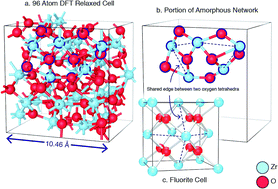Stoichiometry deviation in amorphous zirconium dioxide
Abstract
Amorphous zirconia (a-ZrO2) has been simulated using a synergistic combination of state-of-the-art methods: employing reverse Monte-Carlo, molecular dynamics and density functional theory together. This combination has enabled the complex chemistry of the amorphous system to be efficiently investigated. Notably, the a-ZrO2 system was observed to accommodate excess oxygen readily – through the formation of neutral peroxide (O22−) defects – a result that has implications not only in the a-ZrO2 system, but also in other systems employing network formers, intermediates and modifiers. The structure of the a-ZrO2 system was also determined to have edge-sharing characteristics similar to structures reported in the amorphous TeO2 system and other chalcogenide-containing glasses.



 Please wait while we load your content...
Please wait while we load your content...